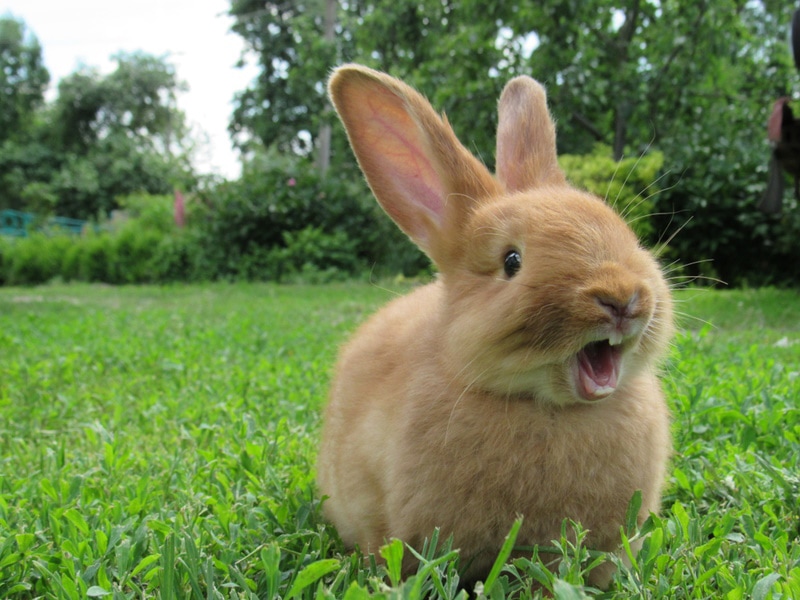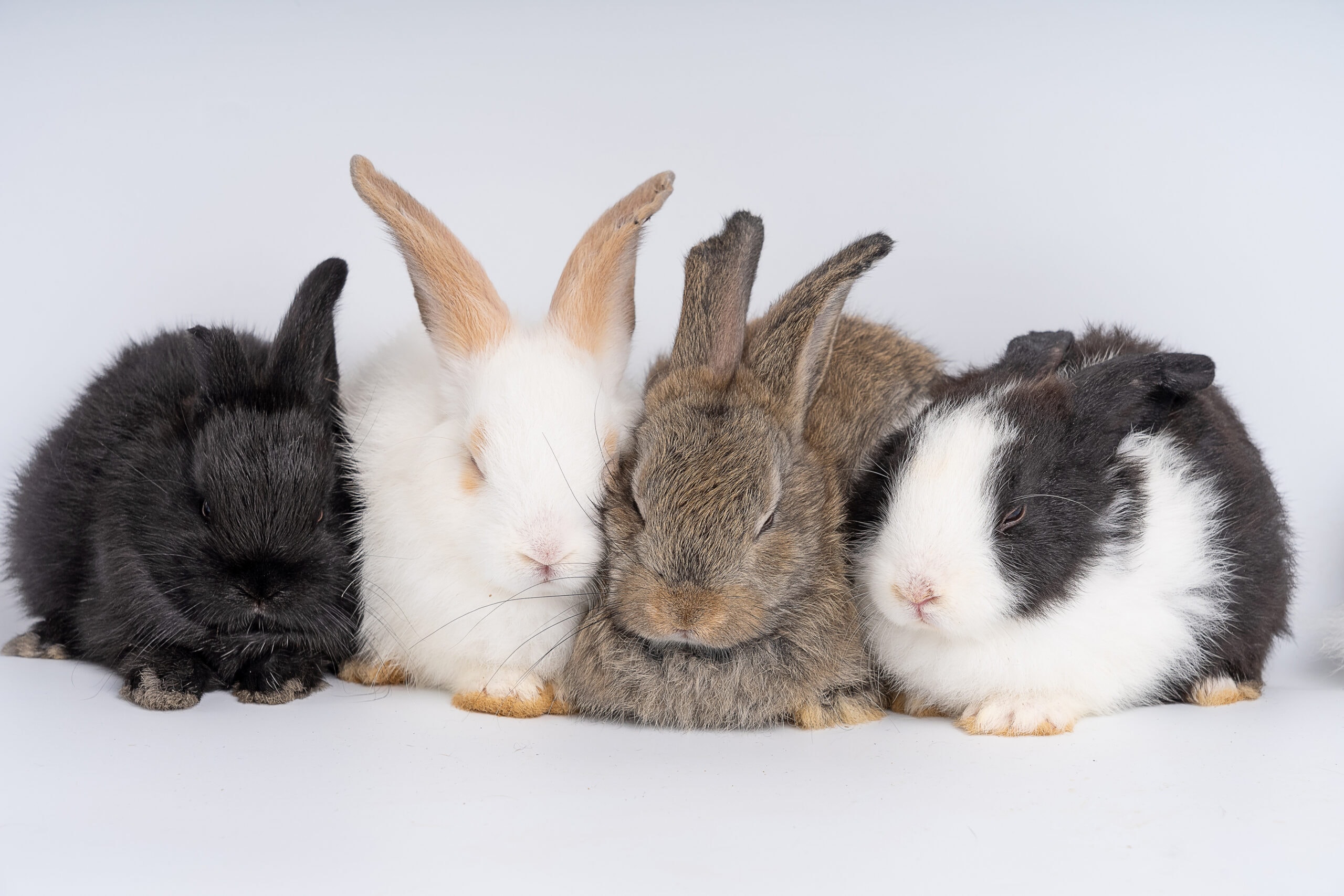Blanc De Termonde: Pictures, Care Guide, Lifespan & Traits
By Beth Crane
Updated on
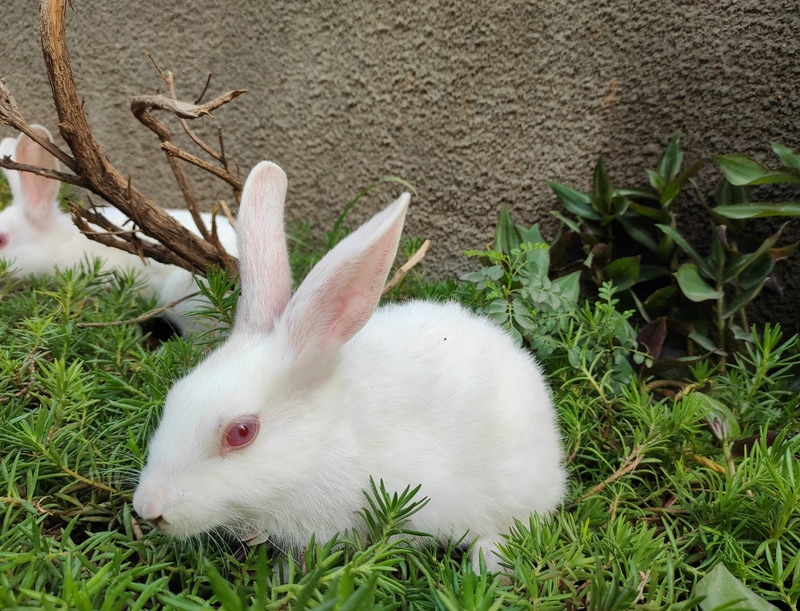
The Blanc De Termonde is a rare rabbit breed only found in Europe and the UK (although its rarity is still apparent even in these places). Startling white, these rabbits are true albinos, having no melanin in their bodies. Their white fur and pink-red eyes are head-turning, but the stark appearance often belies their sweetness and docile nature. We’ll discuss everything you need to know about these mysterious rabbits and find out how they fare as beloved pets.
| Height: | Medium |
| Weight: | 8.8 – 12 lbs |
| Lifespan: | 7 – 10 years |
| Colors: | Beveren, New Zealand White, Florida White |
| Suitable for: | New rabbit owners, owners who have the time to find a reputable breeder, those with school-age children or older |
| Temperament: | Very friendly, calm, easy to handle, gentle, laid back, social |
The gentle Blanc De Termonde is an elusive breed that started its life being bred for the meat trade. In the 1900s, these rabbits were brought over from Belgium on boats to the UK 1. At that time, many rabbits were often bred and sold as a cheap but nutritious source of meat, and the Blanc was no different!
However, the first Blanc was shown in the 1920s (likely because of its beauty). From there, this rare rabbit was almost lost to obscurity despite its gentle temperament. Its gentleness makes it an excellent pet.
Blanc De Termonde Breed Characteristics
How Much Do These Rabbits Cost?
Because of the incredible rarity of the Blanc De Termonde, it was impossible to find a breeder! To ensure accuracy as much as possible, we looked at the most similar breeds of rabbits and delved into how much they cost to buy. The two breeds we included, the Florida White and the New Zealand White, are both of similar size and identical albino coloring. Depending on the location, they cost between $50 and $100, so it wouldn’t be too far off to assume the Blanc would cost a similar amount. However, because of the rarity of the breed and import costs, it could be more expensive. If you find a Blanc in the US, expect to pay at least $100 for it.
Temperament & Intelligence of the Blanc De Termonde
The Blanc De Termonde is a gentle, calm, and easy-to-handle rabbit. While this might be true, remember that most rabbits don’t appreciate being picked up. Rabbits that are well-socialized to be handled and petted will generally enjoy it, and handling is sometimes necessary (such as for veterinary procedures). All rabbits, including the Blanc De Termonde, are intelligent and capable of learning tricks! They are laid-back, which can make motivating them for training a little more tricky, but a sweet treat such as a berry can make all the difference!

Do These Rabbits Make Good Pets? 👪
If you can find one, the Blanc De Termonde makes an excellent pet. They are medium-sized rabbits, making them not too big or small for easy handling. They are calm and easygoing, meaning they’ll be happy to relax beside you and want to interact with you. They’ll need another rabbit to keep them company, and you’ll have to interact with them and give them attention daily to keep them happy.
Does This Rabbit Get Along With Other Pets?
The Blanc De Termonde is described as social and easygoing, so they’ll likely get along well with other pets in the home if they’re well-socialized when younger. While rabbits are prey animals and are naturally the prey of predators such as dogs and cats, there are many examples of dogs, cats, and rabbits living together in harmony.
Good socialization with all the animals involved when they’re younger is key, and helping your Blanc De Termonde feel safe and secure in their environment can also help them be more comfortable around other pets in the home. You should never leave your rabbit and other pets unattended together, even rabbits and smaller pets such as rats or mice, due to the risk of potential injury.
Things to Know When Owning a Blanc De Termonde
Food & Diet Requirements 🥕
Rabbits are obligate herbivores, meaning they cannot digest any animal proteins and, as such, need a diet of plants. Roughage such as hay is the most important element of a Blanc De Termonde’s diet, as it keeps their ever-growing open-rooted teeth at an appropriate length and keeps their digestive system moving.
Around 85% of a Blanc De Termonde’s diet should be free-choice hay that’s always available to them. You can’t give your rabbit too much hay, as they’ll constantly eat it throughout the day to keep their teeth trim, guts moving, and boredom at bay. Baby Blanc De Termondes will need to be fed Alfalfa hay, as it contains more protein and calcium to support their growth. However, when they reach 7 months old, they should be weaned onto hay lower in protein and calcium, such as Timothy or orchard hay.
Other than hay, your Blanc De Termonde can have fresh, leafy vegetables and rabbit pellets in their daily diet. Fresh greens such as broccoli, spring greens, and kale should make up around 10% of your Blanc De Termonde’s diet, with the remaining 5% being made up of high-quality, hay-based rabbit nuggets. Too many rabbit nuggets can cause obesity and digestive upset in rabbits, including diarrhea (which can be fatal).
Treats such as berries, bananas, carrots, and other sugary fruit or veg can be used sparingly as a training tool or a special reward, but they shouldn’t be fed too often. Once or twice a week is fine for fruits and veggies that contain lots of sugar, as too much can cause gastrointestinal upset and obesity.
When you’re introducing any new foods to your Blanc De Ormonde, you should do slow slowly.
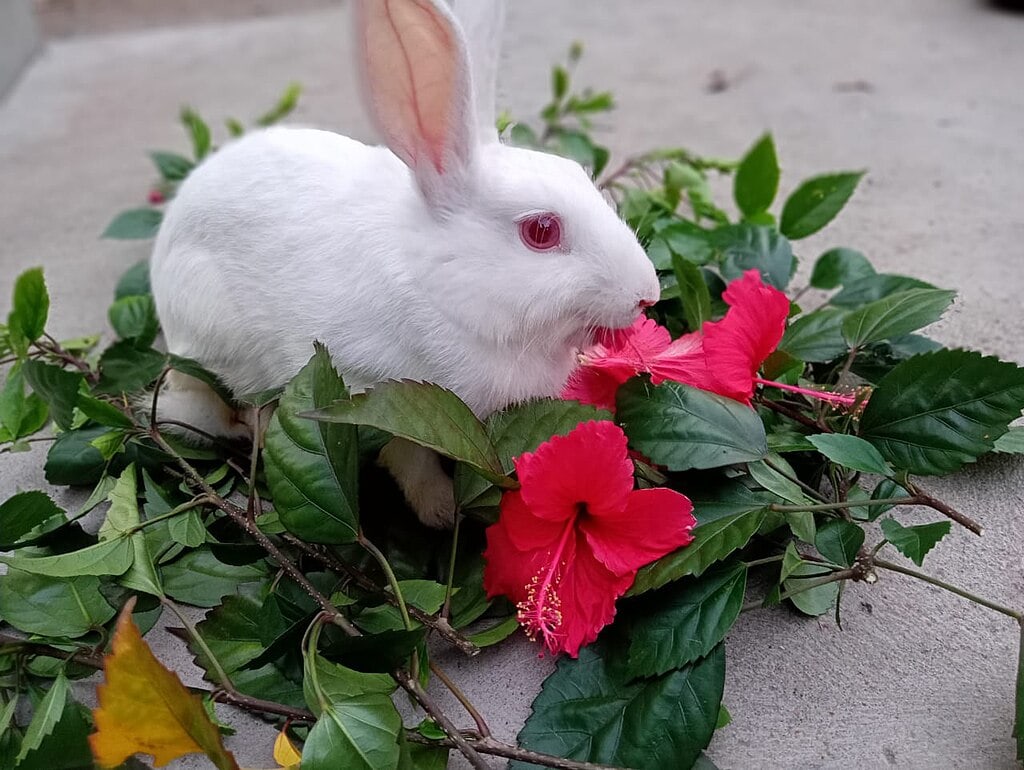
Habitat & Hutch Requirements 🏠
Ideally, your Blanc De Termonde should be kept indoors all year round. Hutches kept outside often don’t provide enough space or ventilation, and your rabbit is more at risk of parasitic infection, infection via virus or bacteria, adverse weather conditions, or predation from wildlife.
- Stand up to their full height without any part of their body touching the ceiling
- Hop four times in any direction
- Lay fully stretched out in any direction without touching any walls
The floor of their living space should be solid since wire can contribute to a painful foot condition known as pododermatitis. The minimum space for a pair of medium-sized rabbits, such as Blanc De Termonde’s, is 30 x 36 inches. They’ll need a litter box, hay, a food bowl, and a water bowl or bottle (or both) inside their living space. Your rabbit’s cage should be spot-cleaned daily, the litter tray changed daily, and the whole cage should be cleaned with a rabbit-safe cleaner once a week.
Exercise & Sleeping Needs 🐇
Rabbits are naturally energetic and agile creatures, and the same is true even for the calm and relaxed Blanc De Termonde! Because of this, rabbits need a safe space to stretch their legs and run in more than just a few hops. A Blanc De Termonde will also need a run or free-roam space to exercise daily.
Ideally, this will be a specialized room in the house that’s completely rabbit-proof. This includes moving any wires or easily chewed hazards out of the rabbit’s reach, removing anything sharp, making the area secure so there are no escapees, and providing toys and enrichment.
Your Blanc De Termonde will need a dark, quiet space away from other members of the household to sleep. Placing their cage in a secure area and away from foot traffic can ensure your rabbits have a safe area to calm down and sleep inside.
Training 🥎
Rabbits are intelligent creatures that are more than capable of learning tricks! Training can go from simple, such as your Blanc De Termonde learning their name or using a litter tray, to more complex tricks, such as spinning around, fetching, or even competitive show jumping! Training with your Blanc De Termonde will offer them enrichment opportunities and increase the bond between you.
Most rabbits will learn how to use a litter box fairly quickly, but some other tricks will take longer. Patience is critical when training your Blank De Termonde, as some rabbits are more interested in the world around them than learning a trick. Using a sweet treat such as a strawberry or a slice of apple can help engage them, but be sure to keep treats to a minimum to prevent stomach upset or obesity.
An important part of training your Blanc De Termonde is getting them acclimatized to having their feet touched, as most rabbits don’t like it. Claw clipping is an integral part of rabbit care, so getting them used to it as early as possible can ensure claw clips are done swiftly and with minimal stress.
Lastly, rabbits should be trained to stay still when they need to be picked up or handled for veterinary procedures or exams.
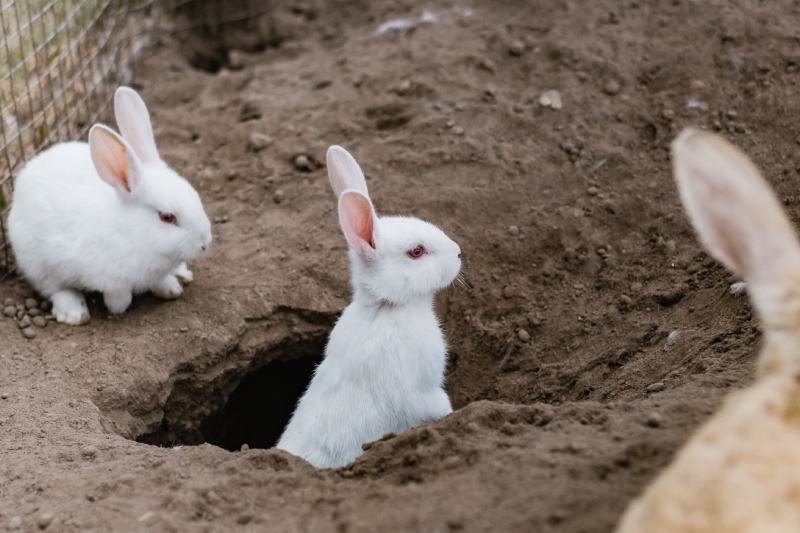
Grooming ✂️
The Blanc De Termonde is a short-haired rabbit, so a gentle brush once a week should be more than enough to keep them groomed and in top condition. Grooming can increase the bond between you, and a good rabbit brush can help remove shed hair from the coat while massaging the skin underneath. You could even incorporate a massage while you’re doing it!
As for bathing, you won’t have to bathe your Blanc De Termonde unless necessary. Bathing should only be done to remove any clumped poop around the back end, and even then, it is usually a rare occurrence. Never use cold or hot water for bathing your rabbit; only use a shallow bath of warm water and make sure they’re thoroughly dried.
Lifespan and Health Conditions 🏥
Blanc De Termonde rabbits live for 7 to 10 years if cared for correctly. They suffer from the same health conditions in all rabbit species, including some less serious (like mites or flea infestation) and some more serious (like gut stasis and fly strike). Many health conditions can be reduced in severity or prevented entirely by a good diet and environment.
- Parasite infection
- Skin Problems
- Gut Stasis
- Fly Strike
- Dental Problems
Serious Conditions:
- Gut Stasis: Gut stasis (or gastrointestinal stasis) is a condition in which a poor diet changes the amount of “good” bacteria in the Gi tract, causing an overgrowth of toxin-producing bacteria. Excessive pain or stress can also cause a rabbit to stop eating, leading to this bacterial imbalance. The gas buildup is very painful, leading to the rabbit eating even less, and the release of toxins can be fatal. This condition should always be treated promptly. Signs of gut stasis include:
- Hunching in pain
- Anorexia
- Teeth grinding
- Not wanting to move
- Not producing poops or reduced poop production
- Collapse
- Fly Strike: Rabbits are susceptible to infestation of fly larvae, commonly blowflies or botflies. These flies are attracted to the smell of urine or feces on your rabbit’s bottom, or they’ll target any areas of infection or open wounds on the rabbit’s skin. The flies will lay eggs on the rabbit, which hatch into maggots that quickly eat the rabbit’s flesh. This is incredibly painful and can quickly become lethal as the infested rabbit is essentially being eaten alive. Treatment should be sought as soon as the condition is noticed or suspected. Check your Blanc De Termonde’s bottom daily for signs of infection, keep them clean and dry at all times, and consider using a preventative treatment such as a rear guard if recommended by your vet. The signs of a fly strike include:
-
- Maggots
- A foul smell
- Pain
- Swelling or movement under the skin
- Wet fur and fur loss
- Dental Problems: Rabbits have teeth that are open-rooted, meaning they never stop growing (like human or canine teeth do). Because of this, rabbits need to chew constantly to keep their teeth fixed down to the correct length, which is why hay is so important! However, teeth that are not aligned properly (malocclusion) can also not rub against each other properly, leading to overgrowth. Tooth spurs can grow out of the molars and dig into the soft skin of a rabbit’s cheek, and incisors can overgrow so much that the roots can end up behind the eye of the rabbit or begin to grow into the cheek. If a rabbit’s teeth are overgrown, they won’t be able to eat and are likely to develop further problems that can be fatal. If you notice any of the following signs, take your rabbit to the vet for an examination:
-
- Watering eyes
- Inappetence
- pain
- Drooling
- Swelling
- Teeth that don’t meet up or grow at an angle
Minor Conditions:
- Parasite infection: Fleas and mites are common parasites, and rabbit-safe preventative treatments are needed to stop them from taking hold. Talk to your vet about the best preventative treatment for your Blanc De Ormonde.
- Skin Problems: Rabbits have sensitive skin that is susceptible to getting irritated. Urine scalding is a common skin condition for rabbits that cannot groom themselves effectively or move around enough. Keeping your rabbit’s environment clean, keeping their skin clean and dry, and keeping them at a healthy weight are all important parts of ensuring their skin is kept healthy and groomed. Fly strike can easily occur in rabbits suffering from sore or irritated skin.
 Male vs Female
Male vs Female
There is little difference between male and female Blanc De Termonde rabbits. The females of the breed may develop a dewlap, which is a soft roll of skin and fat that provides ample nesting fur and a warm place to snuggle babies. However, some male rabbits also develop small dewlaps, although they’re often smaller. Male rabbits are sometimes bigger than females, but it’s almost impossible to tell the difference between them at a glance! The only way to reliably tell a male from a female Blanc De Termonde is by examining their genitals.
3 Little-Known Facts About Blanc De Termondes
1. Blanc De Termondes Were Originally Bred as Meat Rabbits!
2. The British Rabbit Council Recognizes the Blanc De Termonde, but The American Rabbits Breeders Association Does Not.
3. Blanc De Termonde Rabbits Were Originally Bred by Mixing the Largest Rabbit Breed in the World, The Flemish Giant, With One of the Rarest, the Beveren!
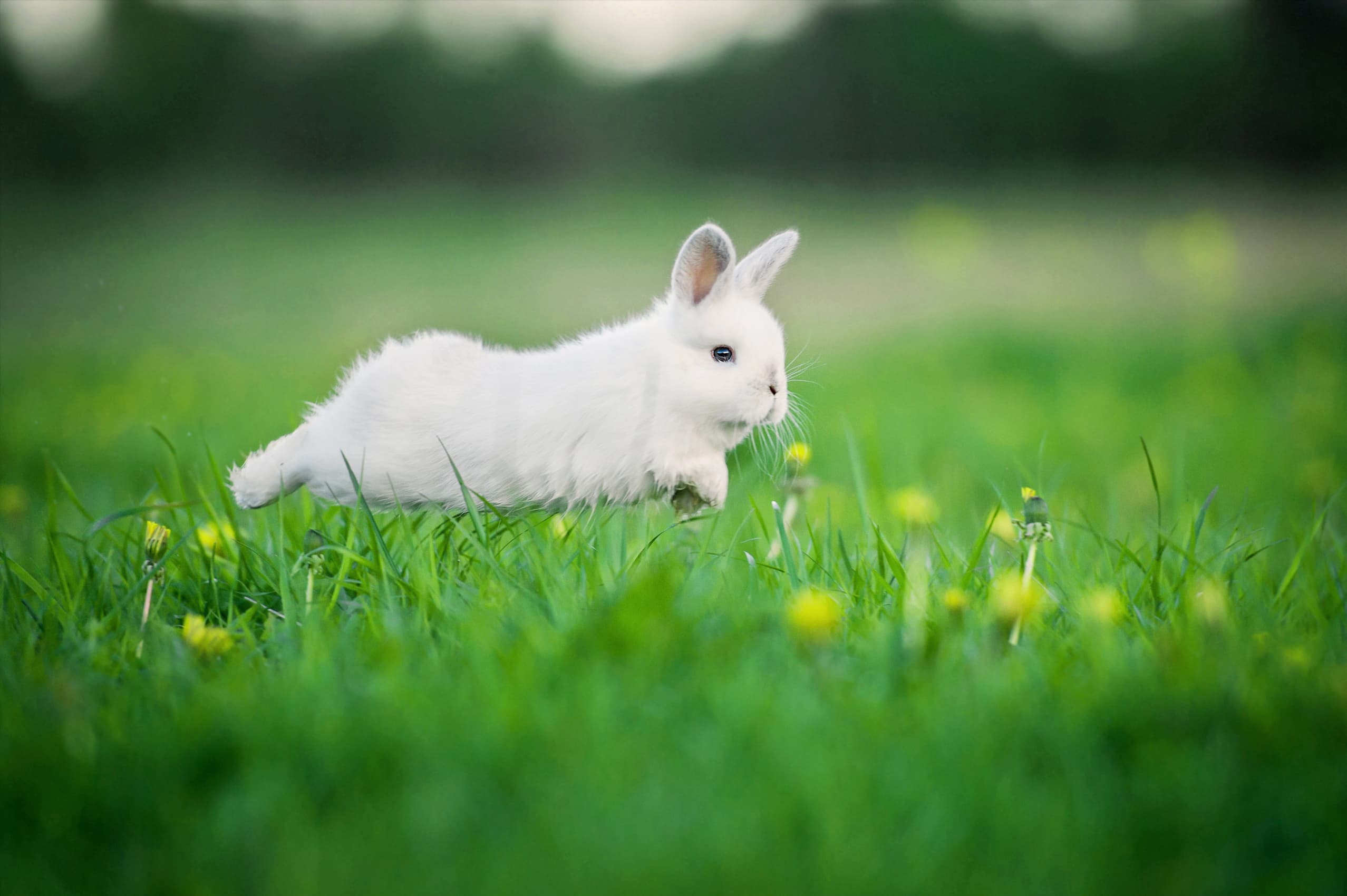
Final Thoughts
Blanc De Termonde rabbits are a true rarity, with very little information surrounding their history or origin available online. The information that is available paints the picture of a very sweet and well-rounded rabbit, however, and one that would make an excellent pet.
Their pure white fur and pinky-red eyes make them all the more special. If you can find a breeder of these beauties, you’ll likely pay well for one due to their rarity. It’s not clear why the Blanc De Termonde fell out of favor with the British rabbit meat trade; perhaps the breed’s fading into obscurity was due to the reduction in overall rabbit meat consumption. No matter the reason, those that have had the pleasure of owning a Blanc De Termonde have said that the breed is pleasant and gentle, making them perfect pets.
See Also:
- Brazilian Rabbit: Facts, Care, Diet, Pictures & More
- Blanc De Blouscat Rabbit: Pictures, Care Guide, Lifespan & Traits
Featured Image Credit: Suresh.Dhadve, Shutterstock


